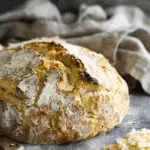Why You’ll Love This Recipe
I love how approachable this recipe is. No yeast, no rising time, no special equipment—just basic pantry ingredients and a little hands-on time. The result is a golden, crusty loaf with a tender crumb and just the right amount of chew. It’s perfect for breakfast, dinner, or snacking, and it always makes the kitchen smell amazing while it bakes.

Ingredients
(Here’s a tip: Check out the full list of ingredients and measurements in the recipe card below.)
-
4 cups (580g) all-purpose flour
-
1½ teaspoons baking soda
-
1 teaspoon salt
-
2 cups (470ml) cold buttermilk
Directions
Step 1 – Prep the Oven and Pan:
I preheat my oven to 400°F (200°C) and prepare a baking sheet by lining it with parchment paper or greasing it well. I’ve also used an 8-inch cake pan or a cast iron skillet with great results.
Step 2 – Mix the Dough:
In a large bowl, I whisk together the flour, baking soda, and salt. Then I stir in the cold buttermilk just until the dough starts to come together and becomes too stiff to stir easily.
Step 3 – Knead and Shape:
I transfer the dough to a lightly floured surface and gently knead it 5–10 times—just enough to bring everything together. Then I shape it into an 8-inch round.
Step 4 – Score the Top:
I place the shaped dough on the prepared pan and use a very sharp knife to cut a shallow “X” across the top, about ¼ to ½ inch deep. This helps the bread bake evenly and gives it that classic soda bread look.
Step 5 – Bake:
I bake the loaf for 45–50 minutes, or until it’s golden brown and sounds hollow when I tap the bottom. For accuracy, I sometimes check with an instant-read thermometer—the center should register around 195°F (90°C).
Servings and timing
This recipe makes 1 round loaf, which yields about 6 to 8 servings. It takes 10 minutes to prepare, 35 to 50 minutes to bake, and is ready in just under an hour. It’s perfect for quick bread cravings or last-minute dinner additions.
Variations
-
Add-ins: I sometimes mix in raisins or dried cranberries for a sweeter twist, or caraway seeds for a more traditional flavor.
-
Whole wheat version: I swap half the flour for whole wheat flour to give the loaf a heartier texture and deeper flavor.
-
Savory upgrade: Chopped herbs, sharp cheddar, or sautéed onions can be added for a savory variation.
-
Mini loaves: I divide the dough into two smaller rounds and reduce baking time slightly for individual portions.
Storage/Reheating
This bread is best served warm on the day it’s baked, but I wrap any leftovers tightly and keep them at room temperature for 2–3 days. I’ve also frozen it successfully—just wrap the loaf or slices in foil and place in a freezer bag for up to 3 months. To reheat, I warm slices in a toaster or reheat a whole loaf in the oven at 300°F until warmed through.
FAQs
Can I substitute regular milk for buttermilk?
Not directly. Buttermilk is essential for the flavor and the chemical reaction with baking soda. If I don’t have buttermilk, I make my own by mixing 2 tablespoons of white vinegar or lemon juice with 2 cups of whole or 2% milk and letting it sit for 5–10 minutes before using.
Why do I need to score the top?
Scoring the top helps the heat reach the center of the loaf and prevents it from splitting unpredictably during baking. It also gives the bread its signature look.
Is this bread supposed to rise much?
It doesn’t rise like a yeast bread, but it should puff up and form a nice dome. If it stays flat, the baking soda may be expired or the dough was overmixed.
Can I knead the dough like regular bread?
No need. I keep kneading minimal—just enough to bring the dough together. Over-kneading can make the loaf dense.
Can I use self-rising flour instead of all-purpose?
I wouldn’t for this recipe. Self-rising flour already contains baking powder and salt, which changes the ratios and can affect both texture and flavor.

Conclusion
This Traditional Irish Soda Bread is one of the simplest, most satisfying bread recipes I make. With just four ingredients, no yeast, and no complicated steps, I get a hearty, rustic loaf every time. It’s perfect for any day I want warm bread without the wait, and it pairs beautifully with both sweet and savory dishes.
PrintTraditional Irish Soda Bread
This classic Irish soda bread is made with just four simple ingredients—no yeast required! A golden, crusty loaf with a tender crumb that’s perfect for soups, stews, or slathered in butter.
- Prep Time: 10 minutes
- Cook Time: 35–50 minutes (based on recipe notes)
- Total Time: ~50 minutes
- Yield: 1 loaf (6–8 servings)
- Category: Bread
- Method: Baked
- Cuisine: Irish
- Diet: Vegetarian
Ingredients
4 cups (580g) all-purpose flour
1½ teaspoons baking soda
1 teaspoon salt
2 cups (470ml) cold buttermilk
Instructions
Preheat oven to 400℉ (200℃). Line a baking sheet with parchment paper, or grease well. You may also use an 8″ cake pan or oven-proof skillet.
Mix dry ingredients: In a large mixing bowl, whisk together flour, baking soda, and salt.
Add buttermilk: Stir in cold buttermilk just until the dough becomes too stiff to stir.
Knead: Turn the dough out onto a floured surface. With floured hands, gently knead 5–10 times until the flour is moistened and the dough holds together.
Shape the dough: Form into an 8″ round loaf. Place on the prepared pan.
Score the top: Use a sharp knife to cut a ¼–½” deep “X” on the top of the dough.
Bake: Bake for 45–50 minutes, or until golden brown. The loaf should sound hollow when tapped on the bottom and read 195°F (90°C) at the center on an instant-read thermometer.
Cool and serve: Let cool slightly, then slice and serve warm or at room temperature.
Notes
Best served fresh, but can be tightly wrapped and stored at room temperature for 2–3 days.
Freezer-friendly: Freeze for 2–3 months. Wrap well in plastic wrap and foil.
Buttermilk substitution: To make your own, combine 2 tablespoons white vinegar or fresh lemon juice with milk to equal 2 cups. Let sit for 5–10 minutes before using.
Do not substitute buttermilk with plain milk—its acidity is essential to the rise and flavor.





